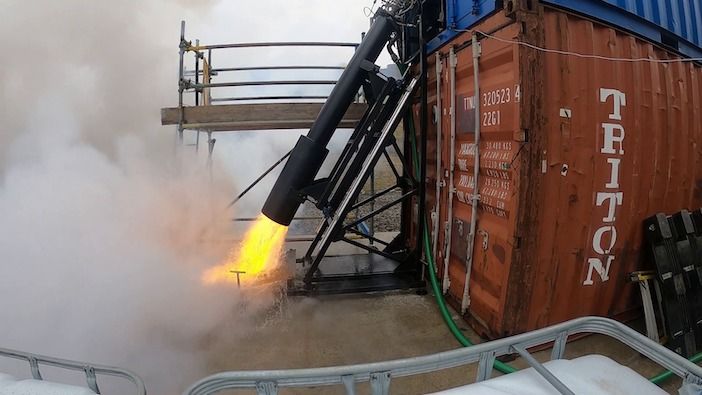UK rocket company, Skyrora, has conducted a series of static test fires of its 3rd stage Low Earth Orbit engine including a vacuum chamber test designed to replicate space-like conditions.
A total of 100 successful test firings have been conducted by the company at its Engine Test Complex located in Fife, Scotland. Skyrora said that the engine, which will be used in its three-stage orbital launcher Skyrora XL, has passed all the necessary test criteria on schedule for Skyrora XL’s planned first launch in 2023.
Skyrora’s Low Earth Orbit (LEO) engine has been designed to be capable of re-igniting numerous amounts of times in orbit. This will enable it to deliver payloads into different altitudes and phases, as required for the mission and acting as a ‘taxi’ service to satellite customers.
Head of engineering, Dr Jack-James Marlow said, “These tests were a fundamental step for our verification programme for the third stage LEO engine, which makes us a stage closer to fully developing our polar orbital vehicle, Skyrora XL. We designed and manufactured a vacuum tube to allow us to lower ambient pressure conditions to approximately 10% of sea level. This is a great technological achievement for Skyrora.”
The primary purpose of Skyrora’s test programme was to verify the life-time cycle according to European Space Agency (ESA) standards for their 3.5kN LEO engine, as well as testing vacuum configuration, operational envelope limits and Thrust Vector Control (TVC). This meant that the engine was fired three times longer than a normal mission required, while also conducting a number of re-ignitions.
A major accomplishment for the Scotland-based company during these 100 tests was that Skyrora’s LEO engine achieved 1,500 seconds of operation within 20 firing tests under vacuum conditions. Skyrora used a gas-dynamic tube, designed and manufactured in-house, to provide the necessary low-pressure environment, as the engine is to be operated in the upper atmosphere.
The 3.5kN engine has the capability to restart in orbit because of the Hydrogen Peroxide system it will use. It is this element that makes it suitable as an orbital manoeuvring unit or a space tug. The functionality of an orbital manoeuvring unit or space tug could include a range of tasks, from space debris removal to aiding in a moon mission.
Skyrora also plans for its launch vehicles, Skylark L and Skyrora XL to use kerosene-equivalent fuel derived from unrecyclable plastic waste called Ecosene as their rocket propellant. Ecosene was sucessfully tested on the LEO engine during January 2020.
The next step for Skyrora is to develop the 70kN engine that will be installed on the first and second stage of the commercial-class orbital vehicle, Skyrora XL. Skyrora is also looking at launch options and locations for their suborbital vehicle “Skylark L”.
Skyrora has already signed over 23 letters of intent with interested customers and is planning to have a launch service agreement in place within the next six months. The company anticipates the creation of up to 170 jobs in Scotland in the coming years.





